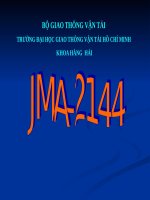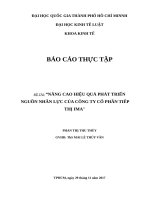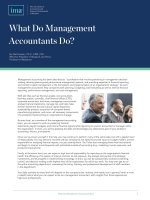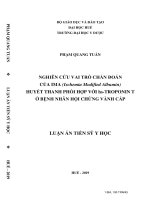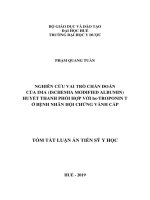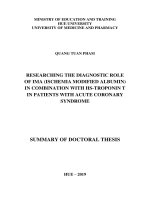IMA DoubleUP
Bạn đang xem bản rút gọn của tài liệu. Xem và tải ngay bản đầy đủ của tài liệu tại đây (1.67 MB, 5 trang )
Educational Outlook
Double Up and Stand Out!
IMA surveys show that dual certification results in significant financial benefits to students. Two highly valued certifications are the CMA and CPA. Here’s a nine-step program whereby highly motivated
undergraduate accounting students can pass the CMA examination before graduation and the CPA exam
within six months after graduation.
Joseph M. Hargadon
Ph.D, CMA, CPA
Professor of Accounting
Widener University
Lori R. Fuller
Ph.D, CPA
Professor of Accounting
West Chester University
Let’s Double Up!
In our August 2015 Strategic Finance article “Double Up and Stand Out!” we assert
that the motivated undergraduate accounting
student could follow our nine-step program
and pass the CMA exam before graduation
and the CPA exam within six months after
graduation. In this excerpt from our original
article we present only our nine-step program.
For the full article, see the August 2015 issue
of Strategic Finance. The 2016 changes to the
CPA exam (which are effective April 2017) do
not affect our recommended study plan and
therefore are not addressed in this excerpt.
Our nine-step streamlined approach to dual
certification is designed to show students and
educators that dual certification is very attainable. We recognize that this nine-step plan is
extremely ambitious and may not appeal to all
accounting students. But it’s a viable choice
for those who are highly motivated and dedicated (e.g., honors students). Students majoring in accounting and taking additional
coursework in finance are ideal candidates.
Prepare with
Why Dual Certification?
Accounting certification in general and
dual accounting certification in particular are
financially beneficial. “IMA’s Global Salary
Survey,” published in the March 2015 issue
of Strategic Finance, reports that CMAs had
a median salary that’s 59% higher than nonCMAs. Additionally, in the U.S. report based
on that survey, respondents holding both the
12 NEW ACCOUNTANT
NA 769*****.indd 12
7/18/16 4:15 PM
Table 1: A COMPARISON OF CMA AND CPA EXAM TOPIC AREAS
CMA EXAM
Effective January 1, 2015
CPA EXAM (listed alphabetically by section)
Current as of January 1, 2015
Part 1: Financial Reporting, Planning, Performance and Control
Auditing & Attestation (AUD)
External Financial Reporting Decisions (15%)
Engagement Acceptance/Understanding Assignment (12%-16%)
Planning, Budgeting and Forecasting (30%)
Understanding Entity & Environment (including internal controls) (16%-20%)
Performance Management (20%)
Performing Audit Procedures/Evaluating Evidence (16%-20%)
Cost Management (20%)
Evaluation, Communication & Reporting Audit Findings (16%-20%)
Internal Controls (15%)
Accounting & Review Services Engagements (12%-16%)
Professional Responsibilities (16%-20%)
Part 2: Financial Decision Making
Business Environment and Concepts (BEC)
Financial Statement Analysis (25%)
Corporate Governance (16%-20%)
Corporate Finance (20%)
Economic Concepts & Analysis (16%-20%)
Decision Analysis (20%)
Financial Management (19%-23%)
Risk Management (10%)
Information Systems & Communications (15%-19%)
Investment Decisions (15%)
Strategic Planning (10%-14%)
Professional Ethics (10%)
Operations Management (12%-16%)
Financial Accounting and Reporting (FAR)
Conceptual Framework/Standards & Standard Setting/Financial Statement Presentation
(17%-23%)
Financial Statement Accounts/Specific Transactions and Events: Recognition,
Measurement, Valuation, Calculation, Presentation and Disclosures (54%-66%)
Government Accounting and Reporting (8%-12%)
Nongovernmental not-for-profit Accounting and Reporting (8%-12%)
Regulation (REG)
Ethics, Professional & Legal Responsibility (15%-19%)
Business Law (17%-21%)
Federal Tax Process, Procedures, Accounting & Planning (11%-15%)
Federal Taxation of Property Transactions (12%-16%)
Federal Taxation-Individual (13%-19%)
Federal Taxation-Entities (18%-24%)
NewAccountantUSA.com 13
NA 769*****.indd 13
7/18/16 4:15 PM
Educational Outlook
Table 2: CMA EXAM CONTENT AREAS: WHERE IT IS TESTED ON THE CPA EXAM*
CMA Part 1
External Financial Reporting (15%)
FAR/REG (Tax Implications)
Planning, Budgeting and Forecasting (30%)
BEC
Performance Management (20%)
BEC
Cost Management (20%)
BEC
Internal Controls (15%)
AUD
CMA Part 2
Financial Statement Analysis (25%)
FAR & AUD (Analytical Review)
Corporate Finance (20%)
BEC
Decision Analysis (20%)
BEC
Risk Management (10%)
BEC/possibly AUD (Audit Risk)
Investment Decisions (15%)
BEC
Professional Ethics (10%)
AUD
* The alignment in content does not indicate the degree of overlap in specific topical coverage and the depth of the topics covered.
CPA and CMA designation reported higher
median total compensation ($132,000) than
those holding only the CMA ($128,500), the
CPA ($123,250), or neither ($93,750).
Educational Requirements
In most licensing jurisdictions the CPA
candidate must complete at least their bachelor’s degree (with the requisite number of accounting and business-related credits) to sit
for the CPA exam. Thus, the CPA candidate
cannot concurrently sit for the CPA exam
while they are an undergraduate student.
CMA candidates need not have completed
their degree to be eligible to sit for that exam.
Accordingly, CMA candidates can sit for the
CMA exam while they are still an undergraduate, but must complete a bachelor’s degree,
in any area, within seven years of completing
the CMA examination to be eligible to earn
the designation.
The Nine-Step Approach
Table 1 summarizes the current content
areas tested on each exam. To earn both designations, a candidate must pass a total of six
parts.
We recommend our nine-step plan to
students who are serious about obtaining
professional certification but who may or
may not end up pursuing a career in public accounting. Our recommendations are
based on the assumptions detailed below and
are applied to a student candidate who is an
undergraduate accounting major attending
a college/university that has a two-semester
academic year. Accordingly, the student candidate will:
• Take one exam part at a time to keep
the workload manageable and increase the
chance for success on that particular part.
• Use some form of CMA and CPA Review
preparation program and materials (such as a
review course, software, etc.) in addition to
their coursework.
• Take additional finance credits or consider
a minor in finance.
• Complete the CMA exam while still a student.
Table 2 demonstrates the current alignment in content areas between the CMA and
CPA examinations. The table allows a candidate to easily follow our recommended strategy for sequencing course work and related
CMA and CPA examination parts. It is important to note the significant overlap in content
areas (but not necessarily breadth and depth of
topical coverage within these areas) on Parts 1
and 2 of the CMA exam and the BEC, AUD
and FAR sections of the CPA exam.
The CMA exam has increased its emphasis on the application, analysis, synthesis
and evaluation of advanced finance topics.
Thus, a student who pursues a minor in
finance or at least takes additional credits
beyond the traditional required corporate finance course will be better prepared for this
exam. These additional finance credits will
also help meet the 150 credit hour requirement for the CPA licensure.
Our updated plan is outlined below and
summarized in Table 3:
1. During your junior year, complete the
intermediate accounting sequence (usually
two courses), corporate finance, an information systems course, operations management
and, if possible, a relevant finance elective.
Here we expect that most accounting majors
will have completed coursework in economics, quantitative methods (statistics) and
business ethics by the end of their junior year.
14 NEW ACCOUNTANT
NA 769*****.indd 14
7/18/16 4:15 PM
Table 3: The 9-Step Plan for Preparing for the CMA and CPA Exams While Still an Undergraduate
Step Time Period
Preparation Strategy
Exam Parts & Timing
1
Junior Year
(September to May/June)
· Over course of junior year complete intermediate accounting, information
systems, corporate finance, operations management courses, finance
elective and business ethics course
2
Junior Year
(May-June)
·Use CMA Review Program materials to study for Part 2: CMA
Senior Year
(September-December)
· Complete cost/managerial accounting course
· If available, complete undergraduate business capstone course and/or case
course in finance
· Complete auditing course and possibly take first tax course here
· Use CMA Review Program materials to study for Part 1: CMA
3
Part 2: CMA
End of May or June
4
Senior Year
(Winter Break)
(December – January)
5
Senior Year
(January-May)
6
Graduate with undergraduate
degree (May)
· Take 1-2 weeks off after graduation in May
7
Post-Undergraduate
(June)
· Use CPA Review Program material to prepare for BEC and REG sections of
CPA exam
8
Post-Undergraduate
(July-August)
· Finish preparation for BEC section
· Start and finish preparation for REG section
CPA: BEC in Early July
CPA: REG in Late August
9
Post-Undergraduate
(October/November)
· Use CPA Review Program materials for AUD and FAR
· Study intensively in September, October and early
November
CPA: AUD in Late October
CPA: FAR in Late November **
· Use CMA program materials and intensively prepare for Part 1: CMA
Part 1: CMA
Late January or Early February*
· Complete tax course(s), business law and advanced
accounting courses
*After Step 4, if successful, the candidate has completed the CMA examination prior to graduation.
**After Step 9, if successful, the candidate has completed the CPA examination.
The CMA exam assumes that a candidate has
knowledge in business economics, time-value
of money concepts and basic statistics. (Note:
the BEC section of the CPA exam specifically
tests economics and time-value of money
concepts.) The totality of this coursework
covers the majority of the topics tested on
Part 2 of the CMA exam and is invaluable in
preparing for this part of the exam.
2. In May and June, after your junior year is
complete, use the CMA Review Program materials to prepare intensively for Part 2 of the
CMA exam: “Financial Decision Making.”
Take this part of the exam in late May or June
and recharge in the months of July and August.
3. During the first semester of your senior
year, complete cost/advanced managerial
accounting, auditing and the undergraduate business capstone course, if available.
Typically, capstone courses are case-based
and require application and integration
skills to examine strategic planning, performance and control issues; which are invaluable in preparing for Part 1 of the CMA
exam: Financial Reporting, Planning, Performance and Control. If such a capstone
course isn’t required or available, look for
a case course in finance (elective). At this
point, you should have a solid foundation
in most of the topics tested in Part 1 of the
CMA exam.
4. Over the winter break (January) the
CMA Review Program materials are used to
study for Part 1 of the CMA exam. Plan to sit
for this section in late January or early February of the spring semester. We recommend
this timing because it’s early in the spring semester and likely before major course assignments are due. If you are planning on doing
an internship in the spring semester, we suggest that you request a late January start date.
5. During the second semester of your
senior year, schedule tax, business law and
advanced financial accounting courses. If
this isn’t possible, take the advanced and/or
tax course in the first semester of your senior
NewAccountantUSA.com 15
NA 769*****.indd 15
7/18/16 4:15 PM
Educational Outlook
year. Ideally, you should take two tax courses:
individual taxation and business entity taxation. If available, one tax course could be
taken per semester. Although not common,
a second auditing course is also useful.
6. Upon graduation in May immediately
apply for the CPA examination, parts BEC
and REG and then relax for one to two
weeks (remember, you have already passed
the CMA exam).
7. In June, use the CPA Review Program
materials to prepare for the Business Environment and Concepts (BEC) section of
the CPA exam. Because you recently studied
for the CMA exam, the preparation time for
BEC is considerably shortened since 56%72% of the BEC section content (strategic
planning, operations management, information systems and financial management) were
covered and tested in the CMA exam. Schedule BEC in early July.
8. For the remainder of July and early
August, use the CPA Review Program material for the Regulation (REG) section. If you
completed the business law and tax course(s)
in the last semester as we advised, 85% - 90%
of the content tested on the REG section will
be relatively fresh in your mind, reducing the
amount of study time needed. Schedule the
REG section at the end of August.
9. The real test of your dedication, motivation, and commitment is now at hand,
particularly if you are starting your career in
the fall after graduation. Since the auditing
and advanced financial accounting courses
are relatively fresh in your mind, use September and early October to prepare for
the Auditing and Attestation (AUD) and
Financial Accounting and Reporting (FAR)
sections of the CPA exam simultaneously.
There is synergy gained when studying for
AUD and FAR together since audit issues
such as analytical procedures are tested in
both sections. And, since you have already
passed the CMA exam, you will have reviewed and been tested on many of the Intermediate Accounting topics tested in FAR
and many of the analytics and financial ratios covered in AUD. Schedule AUD in late
October and FAR in late November. This
strategy affords you an additional month
to review FAR. This timing is also desirable
because it is before calendar year-end corporate closings and the public accounting
“busy season”. If successful, you will have
completed both exams by late November,
six months after graduation!
In summary, candidates following this
nine-step plan will take one exam section at
a time (two while a student and four shortly
after graduation) thereby capitalizing on
the timing of their coursework, their testtaking ability and their professional exam
experience. All of this should improve your
likelihood for success on both the CMA and
CPA exams.
Did you know that Illinois has a Masters in Tax Program in Chicago?
Located in the heart of Downtown Chicago, a Masters in Tax from
Illinois will give your career the boost you’ve been looking for.
· One-year program in Downtown Chicago
· Designed for Working Tax Professionals
· Executive Style
· World-Class Faculty
Classes Start May 2017
MastersInTax.com | 312.575.0909
A graduate program of the Department of Accountancy in the
College of Business at the University of Illinois at Urbana-Champaign.
16 NEW ACCOUNTANT
NA 769*****.indd 16
7/18/16 4:15 PM


